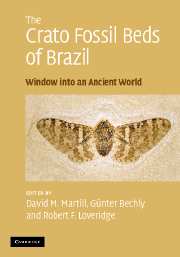Book contents
- Frontmatter
- Contents
- Contributors
- Preface
- Acknowledgements
- Part I The Crato Formation Konservat Lagerstätte
- Part II The invertebrate fauna
- Part III The vertebrate fauna
- 12 The Crato Formation fish fauna
- 13 Anurans of the Crato Formation
- 14 Turtles of the Crato Formation
- 15 Lizards of the Crato Formation
- 16 Crocodilians of the Crato Formation: evidence for enigmatic species
- 17 Pterosaurs of the Crato Formation
- 18 Birds of the Crato Formation
- Part IV The flora
- Part V Miscellanea
- Appendix: species list for the Crato Formation
- Systematic index
- Plate section
- References
13 - Anurans of the Crato Formation
Published online by Cambridge University Press: 22 August 2009
- Frontmatter
- Contents
- Contributors
- Preface
- Acknowledgements
- Part I The Crato Formation Konservat Lagerstätte
- Part II The invertebrate fauna
- Part III The vertebrate fauna
- 12 The Crato Formation fish fauna
- 13 Anurans of the Crato Formation
- 14 Turtles of the Crato Formation
- 15 Lizards of the Crato Formation
- 16 Crocodilians of the Crato Formation: evidence for enigmatic species
- 17 Pterosaurs of the Crato Formation
- 18 Birds of the Crato Formation
- Part IV The flora
- Part V Miscellanea
- Appendix: species list for the Crato Formation
- Systematic index
- Plate section
- References
Summary
Introduction
The Anura – frogs and toads of common parlance – comprise about 5,250 extant species with a near world wide distribution, excluding only Antarctica, the highest latitudes of the Northern Hemisphere and the marine realm. Their unique morphology, physiology and behavioural adaptations allow anurans to inhabit a wide range of environments, from the arctic tundra to hot arid deserts. However, they achieve their maximum diversity in the Neotropical rainforests (Duellman and Trueb, 1994; Hofrichter, 2000), where they prefer moist environments. Most species are required to return to freshwater environments for the development of their larvae.
Their temporal range begins in the Triassic if the pro-anurans of Madagascar and Poland are considered anurans. True anurans are relatively scarce in the Mesozoic, only becoming common and diverse in the Cenozoic (Roček, 2000). The earliest occurrence of a true anuran is Prosalirus bitis Shubin and Jenkins, 1995, from the Lower Jurassic of Arizona. This taxon achieved the basic anuran body plan that has persisted without significant modification for approximately 200 myr. Of the present 33 anuran families, five have a fossil record extending to the Mesozoic (Leiopelmatidae, Discoglossidae, Pipidae, Pelobatidae and Leptodactylidae), and one family, † Palaeobatrachidae, is exclusively Mesozoic. All but the † Palaeobatrachidae occur in Gondwana (Roček, 2000; Gao and Chen, 2004).
Anurans were first reported in the Crato Formation by Kellner and Campos (1986), where they occur only in the Nova Olinda Member (see Maisey, 1991: 325 for figure).
- Type
- Chapter
- Information
- The Crato Fossil Beds of BrazilWindow into an Ancient World, pp. 444 - 451Publisher: Cambridge University PressPrint publication year: 2007
References
- 7
- Cited by



